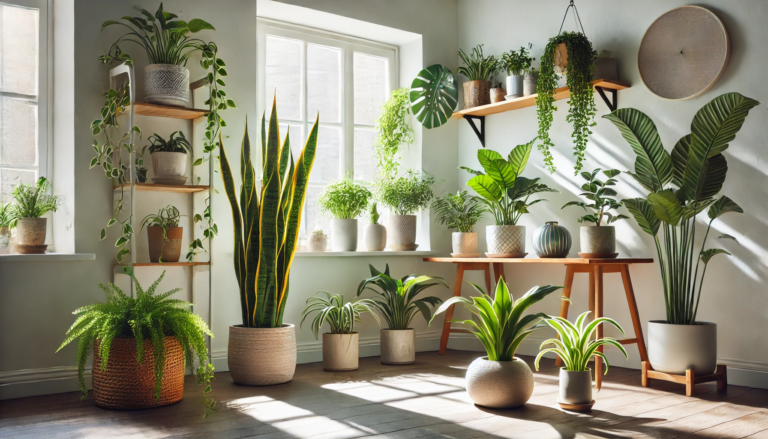Indoor plants not only enhance your home’s aesthetic appeal but also contribute significantly to improving indoor air quality. By filtering toxins, increasing oxygen levels, and boosting humidity, certain plants can make your living environment healthier and more comfortable. In this comprehensive guide, we’ll explore the benefits of air-purifying plants, highlight the best species for your home, and provide tips to care for them effectively.
The Science Behind Air-Purifying Plants
Plants purify the air by absorbing carbon dioxide during photosynthesis and releasing oxygen. Some species also filter harmful toxins found in common household items, breaking them down into harmless compounds. The root zone, combined with beneficial soil microbes, enhances this purification process. A NASA study in the 1980s confirmed that specific plants could remove indoor air pollutants such as benzene, formaldehyde, and trichloroethylene, making them invaluable for improving air quality.
Common Indoor Pollutants and Their Sources
Indoor air pollutants can originate from everyday items. Formaldehyde, found in particleboard furniture and household cleaners, is a frequent culprit. Benzene, emitted by paints, varnishes, and synthetic materials, is another harmful chemical. Trichloroethylene, used in adhesives and dry-cleaning solutions, can linger in the air. Additionally, xylene and toluene, common in adhesives and certain floor coverings, can negatively affect respiratory health. By introducing air-purifying plants, you can naturally reduce the impact of these toxins.
Best Air-Purifying Plants for Your Home
Snake Plant, also known as Sansevieria trifasciata, is a resilient option that removes toxins such as formaldehyde and benzene. It thrives in low to bright light and requires watering only every two to three weeks. Peace Lily, or Spathiphyllum, is both elegant and effective, filtering ammonia, benzene, and formaldehyde. Keep the soil moist and place it in indirect light. Areca Palm, Dypsis lutescens, increases humidity while removing xylene and toluene. It needs bright, indirect light and consistent watering. Spider Plant, Chlorophytum comosum, is easy to grow and reduces carbon monoxide and formaldehyde. It thrives in indirect light and tolerates occasional neglect. Boston Fern, Nephrolepis exaltata, acts as a natural humidifier and removes formaldehyde and xylene. It prefers high humidity and consistent watering. Rubber Plant, Ficus elastica, absorbs airborne toxins and adds a bold decorative touch. Place it in bright, indirect light and water when the soil is slightly dry. Aloe Vera, Aloe barbadensis miller, releases oxygen at night and filters formaldehyde. It thrives in bright light and requires minimal watering. Bamboo Palm, Chamaedorea seifrizii, adds a tropical feel while filtering benzene and formaldehyde. Provide bright, indirect light and ensure regular watering.
Strategic Placement of Air-Purifying Plants
The placement of your air-purifying plants can enhance their effectiveness. In the living room, large plants like the Areca Palm or Rubber Plant improve air circulation and add a lush ambiance. In the bedroom, Snake Plants and Aloe Vera release oxygen at night, promoting restful sleep. Kitchens benefit from Spider Plants and Peace Lilies, which combat cooking fumes and odors. Bathrooms, with their high humidity, are ideal for Boston Ferns or Bamboo Palms.
Caring for Air-Purifying Plants
To keep your plants thriving, maintain consistent care routines. Most air-purifying plants prefer soil that is evenly moist but not waterlogged. Allow the top inch of soil to dry between waterings, and use distilled or rainwater for sensitive species like ferns. Light requirements vary by species, so place plants in suitable spots and rotate them occasionally for even growth. Dust can accumulate on leaves, reducing their air-purifying efficiency, so wipe them gently with a damp cloth every few weeks. Fertilize plants every four to six weeks during the growing season to promote healthy growth. Monitor for common pests like spider mites and mealybugs, treating infestations promptly with neem oil or insecticidal soap.
Benefits Beyond Air Purification
Air-purifying plants offer additional advantages. They reduce stress levels and boost mood, creating a calming environment. Greenery in workspaces improves focus and productivity, enhancing your home office setup. These plants also add aesthetic appeal, with their diverse shapes, sizes, and colors enhancing any decor style.
Addressing Common Challenges
Sometimes, even with proper care, challenges may arise. Yellowing leaves often result from overwatering or insufficient light. Adjust watering routines and reposition the plant if necessary. Brown tips are usually caused by low humidity; mist plants or use a humidifier to resolve this. Drooping plants typically indicate underwatering or root issues. Check soil moisture and address any drainage problems.
Creating a Greener Future
Incorporating air-purifying plants into your home is a simple yet impactful way to create a healthier living environment. These plants connect us with nature, promoting mental well-being and environmental consciousness. By nurturing greenery indoors, you contribute to a greener, more sustainable future.
Final Thoughts
Air-purifying plants are a valuable addition to any home, offering the dual benefits of cleaner air and enhanced aesthetics. By selecting the right species, placing them strategically, and maintaining consistent care, you can transform your living space into a sanctuary of health and beauty. Start with a few plants and gradually expand your collection, creating an indoor environment that supports both your well-being and the planet.

